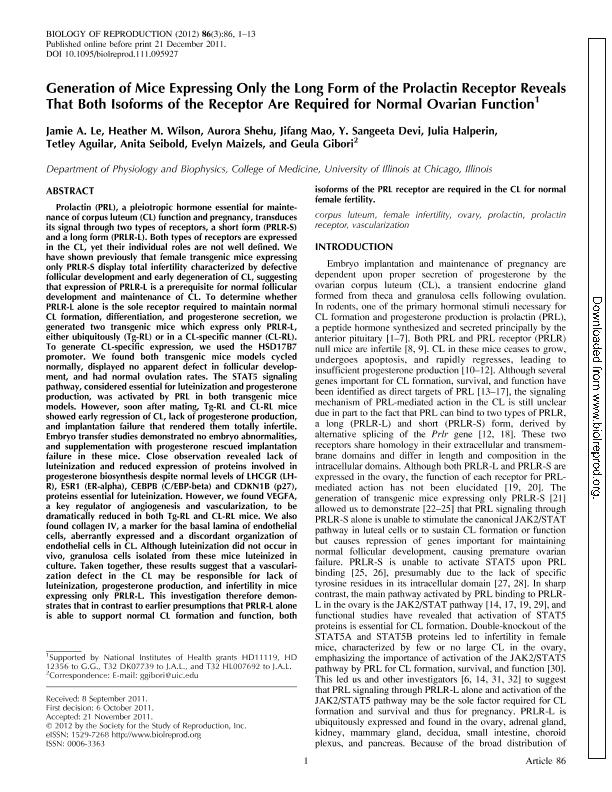Artículo
Generation of mice expressing only the long form of the prolactin receptor reveals that both isoforms of the receptor are required for normal ovarian function
Le, Jamie A.; Wilson, Heather M.; Shehu, Aurora; Mao, Jifang; Devi, Y. Sangeeta; Halperin, Julia ; Aguilar, Tetley; Seibold, Anita; Maizels, Evelyn; Gibori, Geula
; Aguilar, Tetley; Seibold, Anita; Maizels, Evelyn; Gibori, Geula
 ; Aguilar, Tetley; Seibold, Anita; Maizels, Evelyn; Gibori, Geula
; Aguilar, Tetley; Seibold, Anita; Maizels, Evelyn; Gibori, Geula
Fecha de publicación:
01/2012
Editorial:
Society for the Study of Reproduction
Revista:
Biology of Reproduction
ISSN:
0006-3363
Idioma:
Inglés
Tipo de recurso:
Artículo publicado
Clasificación temática:
Resumen
Prolactin (PRL), a pleiotropic hormone essential for maintenance of corpus luteum (CL) function and pregnancy, transduces its signal through two types of receptors, a short form (PRLR-S) and a long form (PRLR-L). Both types of receptors are expressed in the CL, yet their individual roles are not well defined. We have shown previously that female transgenic mice expressing only PRLR-S display total infertility characterized by defective follicular development and early degeneration of CL, suggesting that expression of PRLR-L is a prerequisite for normal follicular development and maintenance of CL. To determine whether PRLR-L alone is the sole receptor required to maintain normal CL formation, differentiation, and progesterone secretion, we generated two transgenic mice which express only PRLR-L, either ubiquitously (Tg-RL) or in a CL-specific manner (CL-RL). To generate CL-specific expression, we used the HSD17B7 promoter. We found both transgenic mice models cycled normally, displayed no apparent defect in follicular development, and had normal ovulation rates. The STAT5 signaling pathway, considered essential for luteinization and progesterone production, was activated by PRL in both transgenic mice models. However, soon after mating, Tg-RL and CL-RL mice showed early regression of CL, lack of progesterone production, and implantation failure that rendered them totally infertile. Embryo transfer studies demonstrated no embryo abnormalities, and supplementation with progesterone rescued implantation failure in these mice. Close observation revealed lack of luteinization and reduced expression of proteins involved in progesterone biosynthesis despite normal levels of LHCGR (LHR), ESR1 (ER-alpha), CEBPB (C/EBP-beta) and CDKN1B (p27), proteins essential for luteinization. However, we found VEGFA, a key regulator of angiogenesis and vascularization, to be dramatically reduced in both Tg-RL and CL-RL mice. We also found collagen IV, a marker for the basal lamina of endothelial cells, aberrantly expressed and a discordant organization of endothelial cells in CL. Although luteinization did not occur in vivo, granulosa cells isolated from these mice luteinized in culture. Taken together, these results suggest that a vascularization defect in the CL may be responsible for lack of luteinization, progesterone production, and infertility in mice expressing only PRLR-L. This investigation therefore demonstrates that in contrast to earlier presumptions that PRLR-L alone is able to support normal CL formation and function, both isoforms of the PRL receptor are required in the CL for normal female fertility.
Archivos asociados
Licencia
Identificadores
Colecciones
Articulos(SEDE CENTRAL)
Articulos de SEDE CENTRAL
Articulos de SEDE CENTRAL
Citación
Le, Jamie A.; Wilson, Heather M.; Shehu, Aurora; Mao, Jifang; Devi, Y. Sangeeta; et al.; Generation of mice expressing only the long form of the prolactin receptor reveals that both isoforms of the receptor are required for normal ovarian function; Society for the Study of Reproduction; Biology of Reproduction; 86; 3; 1-2012; 1-13
Compartir
Altmétricas



